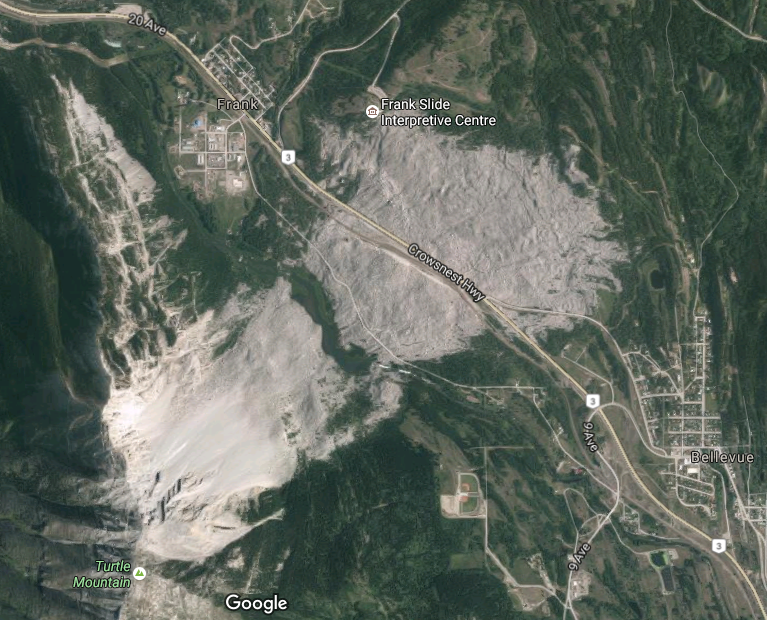Earth Is Our Home: How Planet Earth Responds to Human Activity
The Frank Slide: The Story of Turtle Mountain
MINDS ON

 See, Think, Wonder - The Frank Slide
See, Think, Wonder - The Frank Slide
The following video takes you on an aerial flyover of the Frank Slide location near Crowsnest Pass, Alberta, as depicted in the image above. This rockslide happened in 1903 - over hundred years ago. As you watch the video, consider the following questions and use them to guide the completion of the “see, think, wonder” organizer.
Questions:
- Where did the rockslide start, travel, and end?
- What evidence is there in the video that nature has taken over or natural processes have altered the location since 1903?
- What connections can you make between the barren, boulder-filled landscape and the Earth’s ability to recover after a major disturbance like a landslide/rockslide?
- What role do you think people played in the occurrence of the rockslide?
Make sure that your comments in the “see, think wonder” organizer have some connection to the above questions.
ACTION
The story of Turtle Mountain is a cautionary tale of how good environmental stewardship is often trumped by economic or political concerns, resulting in a variety of social impacts.
 Questions
Questions
- Considering the bolded words above, which concept of geographic thinking are we focusing on in activity 4?
- Spatial significance
- Patterns and Trends
- Interrelationships
- Geographic Perspectives
d. Geographic Perspectives
The sentence above contains each of the geographic perspectives that will be used in our study of the Frank Slide.
Understanding geographic perspectives involves being able to put yourself in the mindset of someone else and think about a situation from their point of view. This activity asks you to think from the perspective of an Indigenous person or a Western miner.
 Study - The Frank Slide
Study - The Frank Slide
Use the "Frank Slide Show" below to gather information on the contrasting perspectives held by the cultural groups that lived in the area of Frank, Alberta during the early 1900’s.
At this point you have a choice of how you will organize the information in the slideshow. Some learners prefer to follow step by step instructions that help lead them through a new study while others are more comfortable independently exploring, confident they will capture the important information as they read. Before you choose, evaluate the merits of each method and choose the one that you think best fits you as a learner.
| Step by Step Graphic Organizer | Independent Exploration (Cornell Note) |
|---|---|
|
PROS:
|
PROS:
|
|
CONS:
|
CONS:
|
Which method will you choose?
| Step by Step Graphic Organizer | Self Exploration (Cornell Note) |
|---|---|
| Fill in this graphic organizer as evidence of your learning. | Complete this Cornell Note Template as evidence of your learning. Explore this website to help you with Cornell Notes. |
Complete the study using the method of your choice.
FrankSlide
CONSOLIDATION
 Perspectives
Perspectives
Using what you learned in the graphic organizer, answer one of the following questions in the class discussion and provide a comment to your classmates answers for each question you did not answer.
Questions:
- In our profit driven western perspective of resource extraction, is it possible to extract resources sustainably? Why or Why not?
- How might specific cultural practices (such as seasonal migration) have led the Blackfoot to be better stewards of the environment? Discuss specific aspects.
- If you were a coal miner or the mine owner in Frank during the months leading up to the slide, why would you ignore the warning signs of a “moving mountain”? Make inferences and share several motivating factors.